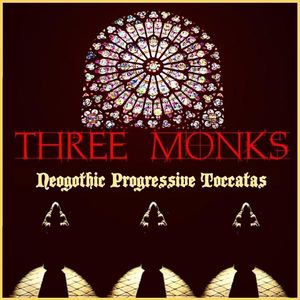During my childhood my parents more or less forced me to go to church on Sundays, something that I didn't like that much. In fact I never was much of a religious guy. However, when the church organ began to play I was all ears. The sound of that organ made a big impression on me! Since these days I was fascinated by this impressive instrument and I loved it a lot when it was used on progressive rock albums. Sadly not that many musicians used a church organ. Only a few names crossed my mind like Rick Wakeman, Jacula, Rick van der Linden solo and with Trace and Ekseption, and Thijs van Leer with Focus. To my surprise a rather new Italian band from Arezzo called Three Monks are totally focused on making music with a leading role for the pipe organ. On their album Neogothic Progressive Toccatas they created an original sound for which organist and composer Paolo Lazzeri is principally responsible. He's assisted by Maurizio Bozzi on bass guitar and by Roberto Bichi and Claudio Cuseri on drums. Lazzeri was a prog rock organist in the early seventies until he began to study romantic classical music, both symphonic and for solo organ. His prime influences came from the in-depth study of the music of composer Julius Reubke (1824-1858) and from progressive rock made by King Crimson and Van der Graaf Generator. Together with Bozzi he decided to form a rock trio with the intention to combine classical music − neo-Gothic style and German Romanticism of the nineteenth century − and progressive rock. Bozzi has been a professional bassist, composer and arranger since the seventies and has collaborated in countless studio projects and live tours. I can't tell you much about the drummers. I have no idea why Bozzi and Lazzeri used two drummers, but fact is that the largest drum parts were played by Roberto Bichi; Claudio Cuseri only played on the first and the last track. It's evident that this album is a church organ purist's dream. The various tracks have been inspired by baroque composers and stories of cathedrals with huge, historical pipe organs. The liner notes will provide you specific information of each track's inspiration. This CD is almost completely instrumental. There are no vocals other than mysterious monk choirs at the beginning of Neogothic Pedal Solo. All tracks have a high musical level and it's obvious that some skilled musicians are at work here. If you have more knowledge of classical music, you'll hear the influences and tributes to the many great classical composers throughout the album. However, not all tracks are based on these composers. One of the album's highlights Deep Red (Profondo Rosso) is an amazing adaptation of Goblin's classic theme from Dario Argento's movie Profondo Rosso. Goblin's original version was also mainly played on pipe organ and this version undoubtedly has the same high calibre! The next track Profondo Gotico is a marvellous continuation of the previous theme with many classical variations. On the final and longest track Toccata Neogotica Number 7 everything comes together. I think this is the ultimate highlight of the album. If you like music performed on a pipe organ accompanied by a fine rhythm section you'll certainly love the rather unique music created by Three Monks. In spite of that I think many devotees of progressive rock music don't have any affection with this kind of musical experiments. They might have enough of this style of music after listening to one or two tracks. But that doesn't apply to me. I loved it all the way until the last dying seconds. However, there's only thing that bothers me. In an interview with Paolo Lazzeri, he should have said that the album was recorded with synthesizers instead of a real pipe organ... ***+ Henri Strik (edited by Peter Willemsen) Where to buy? |
